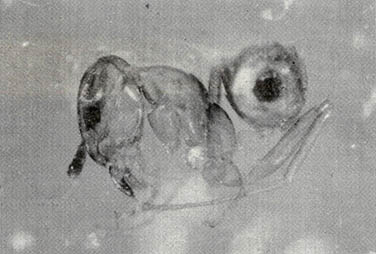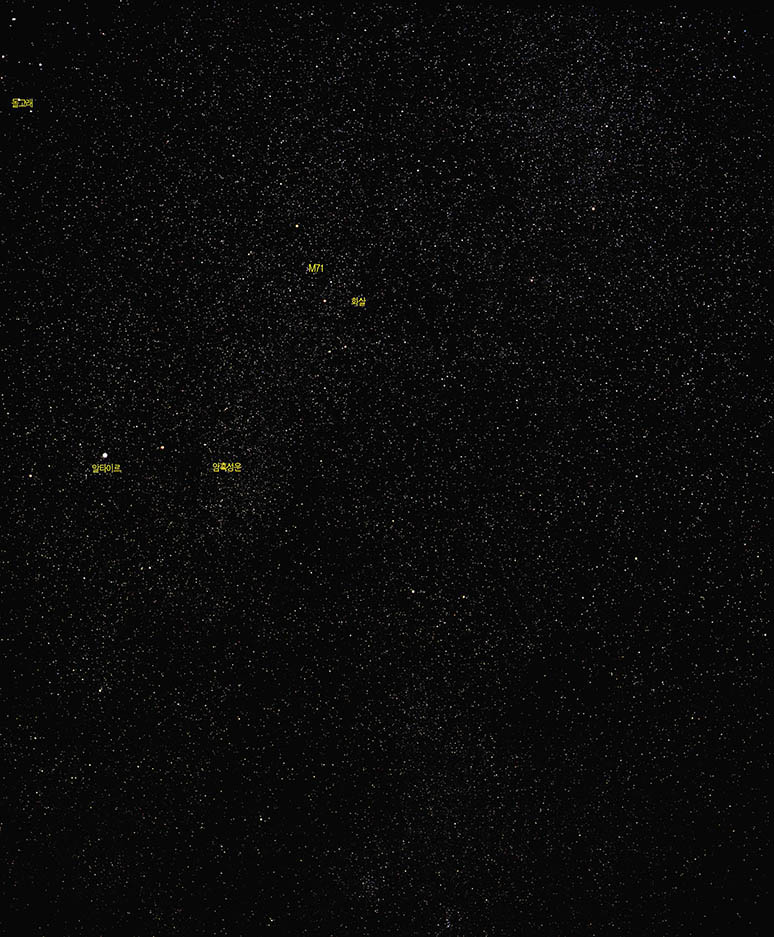수 백만년 전의 곤충이 호박에 간직되어 있다는 사실을 모르는 사람은 아직 베스트셀러나 영화 광고를 보지 못한 사람일 것이다. 새롭게 살아나서 마구 날뛰는 공룡이야기가 아직은 픽션이지만 호박에 관한 이야기는 사실이며 그안에 가득찬 비밀이 과학자들에 의해 밝혀지고 있다.
호박은 수지(樹脂)가 굳은 것이다. 주로 소나무와 전나무와 같은 침엽수 껍질에서 배어나오는 수지의 처음 형태는 물렁하고 끈적이는 유기중합체다. 다른 종류의 초목이나 개각층도 수지를 배출하지만 그 양은 나무에 미치지 못한다. 수지는 지금도 배출되고 있으며 그 중 일부는 결국 호박이 되기도 한다.
사람들은 오랫동안 호박을 좋아해왔다. 호박은 촉감도 좋으며 조각을 새길 수도 있다. 고대에는 호박 장신구가 악운을 물리쳐준다고 믿어져 왔다. 그것은 아마 옷감에 문지르면 정전기를 띠게 되는 흥미로운 성질이 호박에 있었기 때문일 것이다.
호박의 여러 조각들은 수지에 붙어버린 모든 것을 그대로 보관하고 있다. 예를 들면 나뭇잎 깃털 솜털 작은 개구리와 도마뱀, 그리고 특히 많은 곤충들이 갇혀 있다.
1982년 로베르타 헤스 포이너와 그녀의 남편이며 곤충학자인 조지 포이너 2세는 호박 안에 담겨 있는 4천만년 전의 각다귀 한 마리를 전자 현미경으로 조사하였다. 그들은 각다귀의 몸체뿐만이 아니라 내부에 있는 세포핵을 발견하였다. 각 세포핵은 DNA를 가지고 있는데, 이는 모든 생물체의 기관을 형성하는데 쓰이는 구성코드다.
지난해에는 두개의 발견이 신문의 헤드라인을 장식했다. 조지 포이너와 그의 아들 헨드릭, 그리고 캘리포니아 종합기술대학의 카노는 2천5백만년에서 4천만년 정도된 도미니카 호박에서 멸종되어 버린 '프로플리비아 도미니카나'라는 침없는 벌의 DNA를 채취하였다.
뉴욕 자연사 박물관 소속의 곤충학자인 드살레와 그리말디, 생물학자인 휠러, 그리고 예일대학의 지질학자 존 게트지로 이루어진 팀은 2천5백만년에서 3천만년 정도에서 멸종되어버린 흰개미의 DNA를 채취하였다. 학명이 '메스토터미스 일렉트로도미니쿠스'인 흰개미도 도미니카 호박에서 발견되었는데, 이 종은 열대 오스트레일리아에 살고 있는 '메스토터미스 다우니언시스'라는 토종 개미와도 관련이 있다.
호박 속에 갇혀버린 곤충의 세포에서 DNA를 채취하는 일 자체도 놀라운 작업이다. DNA의 아주 작은 조각은 중합연쇄반응이라는 PCR 기법에 의해서 확대된다. 그리고 효소용액 속에서 DNA는 자기복제를 한다. 요즘의 모든 일이 다 그렇지만 이러한 DNA를 연구하는 기술도 컴퓨터에 크게 의존한다.
지난6월에는 카노, 포이너와 그의 아들 헨드릭 그리고 질병조절 연구소의 피니아젝, 레바논에 있는 아메리카대학의 아프팀 아크라 등이 훨씬 오래된 DNA를 레바논 호박에서 채취하였다. 그 DNA는 침엽수림을 갉아먹는 바구미라고 불리는 딱정벌레의 일종에서 채취된 것이다. 이 바구미는1억 2천만년에서 1억 3천만년전, 즉 공룡이 지구상 최고의 동물이던 백악기 때 나타난 것들이다. 이 DNA는 현재까지 채취되어 연구된 것 중에 가장 오래된 것이다.
호박에서 나온 DNA는 확실히 흥미롭다. 그것은 분자 고생물학이라는 새로운 과학이 생기도록 고무시켜왔다. 그리말디의 말대로 분자 고생물학은 형태학만으로 답하지 못하는 진화론적인 의문을 해결해줄 것으로 기대되고 있다.
호박에서 채취된 DNA의 관점에서 비추어 볼 때, 생명의 정의는 다시 조정되어야 한다고 조지 포이너는 믿고 있다. 만일 그러한 DNA가 살아있는 세포에 들어갈 수만 있다면, DNA 그 자체는 살아 있다고 볼 수 있다. 그의 가정에 의하면 어떤 단위, 예를 들면 기관 세포 또는 분자라도 어떤 최적의 환경에서 성장과 자기복제를 할 수 있거나 직접 단백질 합성을 할 수 있다면 그것은 살아 있다는 것이다.
호박에 관한 것 중 필자가 즐기는 이야기는 아직 DNA에 관한 것은 아니다. 눈에 보이지는 않지만 당대 생명의 소우주를 이루고 있는 듯이 많은 단세포 미생물을 가진 호박이 최근 발견되었다. 이 사실은 크리스찬 바우어가 독일에서 발견한 호박을 조사한 포이너, 그리고 같은 UCLA에 있는 벤자민 웨고너에 의해 밝혀졌다.
2억 2천만년전, 공룡의 시대가 시작되는 삼첩기때 그 호박은 만들어졌다. 그 안에는 발아할 때 생겨난 홀씨와 꽃가루가 있고, 그뿐만 아니라 바닷말과 곰팡이 홀씨, 박테리아, 그리고 단세포 동물인 원생동물까지도 있다.
놀라운 것은 호박에서 나온 미생물과 현재의 미생물이 거의 같다는 것이다. 이 사실이 보여주는 것은 미생물은 다세포 동식물과는 달리 쉽게 형태를 바꾸지 않는다는 것이다. 얼마나 많은 종류의 공룡이 존재하였고, 수백만년을 걸쳐 변해오면서 지구를 지배했는지 생각해보자. 그리고 상대적으로 겨우 수천년 정도에서 일어난 영장류의 변이, 특히 인간에서 일어난 변이도 생각해보자.
호박과 DNA에 관하여 한 마디만 더 해보자. 인공적인 호박이 지금 만들어지고 있으며 DNA는 인간의 세포에서 뽑아낼 수 있다. 다음의 베스트셀러는 미래의 세대가 그들의 조상을 재창조해낼 수 있도록 인간의 DNA를 인공호박에 넣는 일에 관한 것이 될 것이다. 혹 선조들의 DNA를 담은 호박을 장신구로 달고 다니는 이야기일지도 모른다.

Anyone who doesn't know that amber can preserve insects millions of years old has not been reading best-sellers or watching ads for movies. Newly alive, rampaging dinosaurs may be fictional — so far — but amber is real, and chock full of secrets now being revealed to scientists.
Amber is hardened resin that begins as a soft, sticky organic polymer that is exuded mainly from the bark of coniferous trees like pines and firs. Other plants and some scale insects also produce resin, but not the amounts that come from trees. Resin is still being produced nowadays, and some of that may eventually become amber.
Amber has always been enjoyed by human beings. It feels good to the touch and can be carved. In ancient days, amber jewelry was supposed to ward off bad luck, perhaps because it has the interesting property of getting charged with statio electricity when rubbed with a cloth.
Many pieces of amber contain and preserve whatever became trapped in the resin — leaves, feathers, fur, small frogs and lizards, and above all, insects.
In 1982, Roberta Hess-Poinar and her husband, entomologist George O. Poinar Jr., used an electron microscope to examine a gnat inside amber 40 million years old. They found not only the outside of the gnat's body, but the inside, too, including muscle cells with nuclei still in each. Cell nuclei contain DNA, nature's architectural code for building the organism.
Last year two discoveries made the headlines. George Poinar, his son Hendrik, and molecular biologist Raul J. Cano of California Polytechnic State University in San Luis Obispo, extracted DNA from the cells of an extinct stingless bee called Proplebeia dominicana, found in Dominican amber that is 25 to 40 million years old.
DNA was extracted from an extinct termite 25 to 30 million years old by entomologists Rob De-Salle and David Grimaldi, biologist Ward Wheeler — all at the American Museum of Natural History in New York — and geologist John Gatesy, of Yale University. The termite, Mastotermes electro-dominicus, was also found in Dominican amber, and is related to the primitive Mastotermes darwiniensis, which lives in tropical Australia.
DNA extraction from the cells of insects trapped in amber is itself an amazing process. Tiny bits of DNA are "amplified" by PCR, the "polymerase chain reaction" technique: in an enzyme solution, the DNA copies itself. The technique, and the study of the DNA, relies heavily on computers (as everything seems to, these days).
This month, much older DNA has been extracted from Lebanese amber by Cano, George and Hendrik Poinar, plus Norman J. Pieniazek from the Centers for Disease Control in Atlanta, Ga., and entomologist Aftim Acra from the American University of Beirut, Lebanon. Their DNA is from a type of beetle called a weevil, one that munches the pulp of conifer trees. This weevil is from the early Cretaceous period, about 120 to 135 million years ago — when dinosaurs were Top Animal on Earth. So far, this is the oldest DNA ever extracted and studied.
DNA from amber is certainly intriguing. It has inspired the new science of molecular paleontology, which hopes, as David Grimaldi put it, to "shed light on evolutionary questions that morphology alone sometimes cannot answer."
George Poinar believes that the definition of life must be re-evaluated in the light of amber-extracted DNA. If this DNA can ever be put into a living cell, perhaps DNA itself can be called alive. He postulates that "any entity — organism, cell or molecule — capable of growth, reproduction or direct protein synthesis when placed in an optimum environment, is alive."
My favorite story about amber is not — not yet — about DNA. Recently amber has been found to contain many well-preserved, single-celled microorganisms, like a microuniverse of invisible life caught at a moment of time. The work was done by George Poinar, again, and Benjamin M. Waggoner, also at the University of California at Berkeley, who examined amber found in Germany by Ulf-Christian Bauer.
This amber is from the Triassic period, 220 million years ago, the beginning of the age of dinosaurs. It contains pollen and spores that were caught during germination. It also has algae, fungal spores, bacteria, and the one-celled animals called protozoa.
The striking thing about these ancient microorganisms from amber is that they are about the same as those living now. This indicates that microorganisms do not readily change shape, the way so many multicellular plants and animals do. Think how many kinds of dinosaurs there were, changing over the millions of years dinosaurs ruled Earth. Or the variation in primates, even in hominids, over our relatively few millennia on Earth.
But one more word on amber and DNA. Synthetic amber is now made. DNA can be extracted from human cells. The next best-seller will probably be about putting that DNA into synthetic amber so that future generations can recreate the forms of their ancestors — or maybe just wear the ancestral DNA in amber jewelry….
(c) 1993, Los Angeles Times Syndicate

















